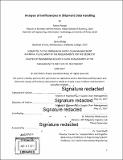| dc.contributor.advisor | Matthias Winkenbach. | en_US |
| dc.contributor.author | Prasad, Rohini, S.M. Massachusetts Institute of Technology | en_US |
| dc.contributor.author | Malaj, Gerta | en_US |
| dc.contributor.other | Massachusetts Institute of Technology. Supply Chain Management Program. | en_US |
| dc.date.accessioned | 2017-12-20T18:15:10Z | |
| dc.date.available | 2017-12-20T18:15:10Z | |
| dc.date.copyright | 2017 | en_US |
| dc.date.issued | 2017 | en_US |
| dc.identifier.uri | http://hdl.handle.net/1721.1/112861 | |
| dc.description | Thesis: M. Eng. in Supply Chain Management, Massachusetts Institute of Technology, Supply Chain Management Program, 2017. | en_US |
| dc.description | Cataloged from PDF version of thesis. | en_US |
| dc.description | Includes bibliographical references (pages 113-116). | en_US |
| dc.description.abstract | Supply chain visibility is critical for businesses to manage their operational risks. Availability of high quality and timely data regarding shipments is a precursor for supply chain visibility. This thesis analyses the errors that occur in shipment data for a freight forwarder. In this study, two types of errors are analyzed: system errors, arising from violations of business rules defined in the software system, and operational errors, which violate business rules or requirements defined outside the software. We consolidated multifarious shipment data from multiple sources and identified the relationship between errors and the shipment attributes such as source or destination country. Data errors can be costly, both from a human rework perspective as well as from the perspective of increased risk due to supply chain visibility loss. Therefore, the results of this thesis will enable companies to focus their efforts and resources on the most promising error avoidance initiatives for shipment data entry and tracking. We use several descriptive analytical techniques, ranging from basic data exploration guided by plots and charts to multidimensional visualizations, to identify the relationship between error occurrences and shipment attributes. Further, we look at classification models to categorize data entries that have a high error probability, given certain attributes of a shipment. We employ clustering techniques (K-means clustering) to group shipments that have similar properties, thereby allowing us to extrapolate behaviors of erroneous data records to future records. Finally, we develop predictive models using Naive-Bayes classifiers and Neural Networks to predict the likelihood of errors in a record. The results of the error analysis in the shipment data are discussed for a freight forwarder. A similar approach can be employed for supply chains of any organization that engages in physical movement of goods, in order to manage the quality of the shipment data inputs, thereby managing their supply chain risks more effectively. | en_US |
| dc.description.statementofresponsibility | by Rohini Prasad and Gerta Malaj. | en_US |
| dc.format.extent | 116 pages | en_US |
| dc.language.iso | eng | en_US |
| dc.publisher | Massachusetts Institute of Technology | en_US |
| dc.rights | MIT theses may be protected by copyright. Please reuse MIT thesis content according to the MIT Libraries Permissions Policy, which is available through the URL provided. | en_US |
| dc.rights.uri | http://dspace.mit.edu/handle/1721.1/7582 | en_US |
| dc.subject | Supply Chain Management Program. | en_US |
| dc.title | Analysis of inefficiencies in shipment data handling | en_US |
| dc.type | Thesis | en_US |
| dc.description.degree | M. Eng. in Supply Chain Management | en_US |
| dc.contributor.department | Massachusetts Institute of Technology. Supply Chain Management Program | |
| dc.identifier.oclc | 1014183630 | en_US |
